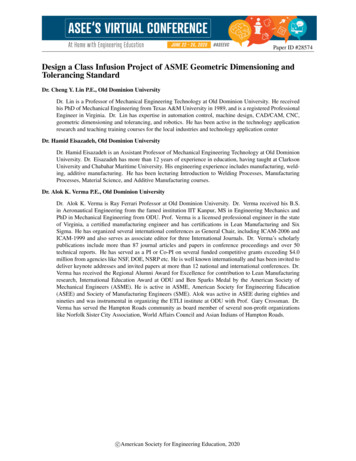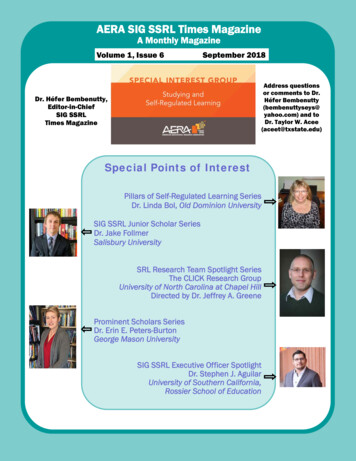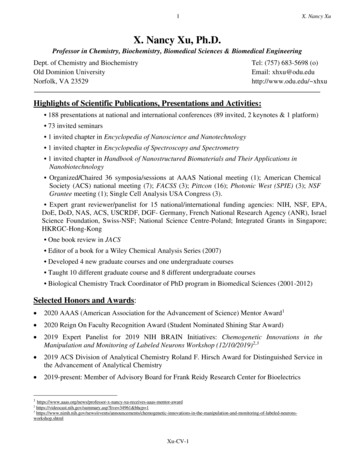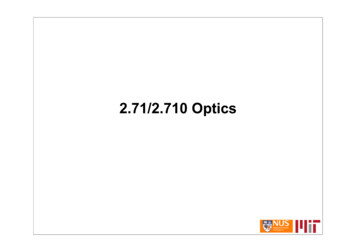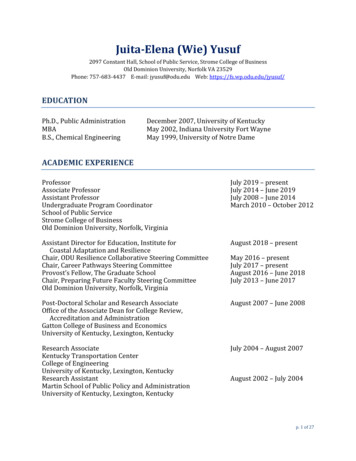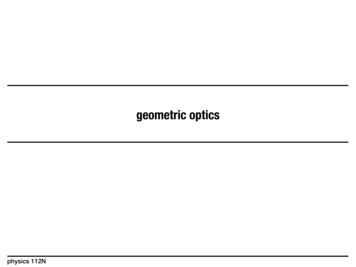
Transcription
geometric opticsphysics 112N
geometric optics of a plane (flat) mirror we’ve already learnt a rule that applies when lightreflects from a smooth surfaceangle of incidence angle of reflectionphysics 112N2
geometric optics of a plane (flat) mirror consider an object which emits sphericalwavefronts, or in other words, rays in everydirection (this is basically anything illuminated) place the object in front of a plane mirror we can draw rays diverging from the object they are reflected at the mirror tracking the reflected rays back they appear tobe diverging from a point behind the mirrorwe call this the imagephysics 112N3
geometric optics of a plane (flat) mirror image formation for an extended objectimageobject consider rays from different parts of the objectwe’ll consider how the eye focusses theimage later when we look at lensesphysics 112N4
geometric optics of a plane refracting surface we’ve already learnt a rule that applies when light refractsat the interface between two mediaSnell’s law :physics 112N7
geometric optics of a plane refracting surface consider an object which emits sphericalwavefronts, or in other words, rays in everydirection place the object in medium a we can draw rays diverging from the object they are refracted at the interface tracking the reflected rays back they appearto be diverging from a different point inmedium awe call this the imagephysics 112N8
quantitative geometric optics we can do better than just these qualitative statements and diagrams we can derive formulae that tell us exactly where the image will be andhow magnified it is relative to the object first we should define some termsobject distanceimage distanceP′P we call this image a virtual image - therays appear to come from P′ but if we puta screen at P′ we wouldn’t see an imagephysics 112Nobjectdistanceimagedistance11
quantitative geometric optics using the fact that angle of incidence angle of reflectionand doing some simple geometry we can find a relationship between s and s′Pphysics 112NP′12
quantitative geometric optics using the fact that angle of incidence angle of reflectionand doing some simple geometry we can find a relationship between s and s′Pphysics 112NP′13
sign rules in optics looks like another annoying thing to remember - but they will turn out to bevery useful when we deal with more complicated optical systems object distance: positivewhen the object is on thesame side of the reflecting orrefracting surface as theincoming rays (otherwisenegative) image distance: positivewhen the image is on thesame side of the reflecting orrefracting surface as theoutgoing rays (otherwisenegative)negative image distancemeans a virtual imagephysics 112N14
plane mirrorP′Pobjectdistancephysics 112Nimagedistance15
quantitative geometric optics - size of objects what about objects that have a size? potentially, reflection or refraction could magnifyor diminish the image relative to the object the same geometric constructionshows that magnification is defined bya plane mirror has m 1physics 112N16
reversal of images although the image in a plane mirror is the same size as the object it is notidentical to it it is reversedphysics 112N17
reflection at a spherical surface mirrors can be made which are not flat butrather shaped like part of a sphere some terminologya convex spherical mirroropticaxiscenter ofcurvaturevertexR “radiusof curvature”a concave spherical mirrorphysics 112N18
reflection at a spherical surface image formation in a spherical mirror angle of incidence angle of reflection still holdsPCP′Va concavespherical mirrorphysics 112N19
reflection at a spherical surface image formation in a spherical mirror defining the object/image distancesPphysics 112NCP′V25
reflection at a spherical surface image formation in a convex spherical mirrorPVP′Ca convexspherical mirrorphysics 112N26
reflection at a spherical surfacePVP′Ca convexspherical mirror is this a real image - would we see an image on a screen placed at P′ ?1. yesphysics 112N2. no27
reflection at a spherical surface image formation in a spherical mirror defining the object/image distancesPVP′Ca convexspherical mirrorphysics 112N28
reflection at a spherical surface a sign convention for the radius of curvaturephysics 112N29
reflection at a spherical surfacea geometric derivationis in the textbook for rays close to the optic axisPphysics 112NCP′V30
the focal point suppose the object is very far away, then the rays from it are almost parallelPCP′Va concavespherical mirrorphysics 112N31
the focal point suppose the object is very far away, then the rays from it are almost parallelPCVa concavespherical mirrorphysics 112N32
the focal point suppose the object is very far away, then the rays from it are almost parallelphysics 112N33
the focal point suppose the object is very far away, then the rays from it are almost parallelphysics 112N34
the focal point suppose the object is very far away, then the rays from it are almost parallelphysics 112N35
the focal point suppose the object is very far away, then the rays from it are almost parallelthe focal pointCphysics 112NFV36
the focal point imagine running this in reverse - put the object at the focal pointproperties of the focal point: any incoming ray parallel to the optic axis is reflected through the focal point any ray passing through the focal point is reflected parallel to the optic axisphysics 112N37
magnification in a spherical mirror do objects get magnified viewed in a spherical mirror ?Cphysics 112NFV38
magnification in a spherical mirror do objects get magnified viewed in a spherical mirror ?Cphysics 112NFV39
graphical method - principal ray tracing we’ll use the formulas soon, but first let’s explore a graphical technique we’ll single out some special rays whose path is easy to work out we call them principal rays a ray parallel to the optic axis is reflected through the focal point of the mirror a ray through the focal point is reflected parallel to the optic axis a ray along the radius passing through the center of curvature is reflectedback along the same line a ray reflecting at the vertex is reflected forming an equal angle to its originaldirection usually drawing any two of these rays describes the image position andsize - drawing more checks our answer no tricky sign conventions herephysics 112N40
graphical method - principal ray tracingCphysics 112NFV41
graphical method - principal ray tracingCFV a ray parallel to the optic axis is reflected through the focal point of the mirrorphysics 112N42
graphical method - principal ray tracingCFV a ray through the focal point is reflected parallel to the optic axisphysics 112N43
graphical method - principal ray tracingCFV a ray along the radius passing through the center ofcurvature is reflected back along the same linephysics 112N44
graphical method - principal ray tracingCFV a ray reflecting at the vertex is reflectedforming an equal angle to its original directionphysics 112N45
image in a concave mirrorA concave mirror has a radius of curvature of absolute value 20 cm.Find the position, reality, magnification and orientation of the image inthe case that the object distance is 30 cmCVFrealimageinvertedimagereduced bya factor of 2physics 112N46
image in a concave mirrorA concave mirror has a radius of curvature of absolute value 20 cm.Find the position, reality, magnification and orientation of the image inthe case that the object distance is 20 cmCVFrealimageinvertedimagesame sizephysics 112N47
image in a concave mirrorrealimageinvertedimagesame sizeCphysics 112NVF48
image in a concave mirrorA concave mirror has a radius of curvature of absolute value 20 cm.Find the position, reality, magnification and orientation of the image inthe case that the object distance is 10 cmCVFreal imageat infinityan observer at any finitedistance will just see a blurrays don’t intersect- no image formedphysics 112N49
image in a concave mirrorA concave mirror has a radius of curvature of absolute value 20 cm.Find the position, reality, magnification and orientation of the image inthe case that the object distance is 5 cmvirtualimageCFVuprightmagnified 2physics 112N50
image in a concave mirrorvirtualimageuprightmagnifiedCphysics 112NFV51
non-principal raysprincipal rays are easy - but once we’ve got the image we should beable to work out the path of any other raysCphysics 112NFV52
non-principal raysprincipal rays are easy - but once we’ve got the image we should beable to work out the path of any other rayscomplete the path of this rayafter reflectionphysics 112N53
non-principal raysprincipal rays are easy - but once we’ve got the image we should beable to work out the path of any other rayscomplete the path of this rayafter reflectionit’s got to appear tocome from the top ofthe imagephysics 112N54
reflection from a convex spherical mirror a spherical mirror is shown and an object isplaced to the left of the mirror’s surfacea convexspherical mirrorphysics 112N
‘thin’ lenses these are the classic optical device - used very widely (how many of you wearglasses or contacts?) - we should learn about their properties two spherical surfaces close enough together that we can neglect the distancebetween themphysics 112N59
focal point of ‘thin’ lenses consider parallel rays entering the lens - from either side technically two focal points - focal lengths the same for a ‘thin’ lens as for mirrors, rays diverging from afocal point are parallel after refractionphysics 112N60
focal point of ‘thin’ lenses consider parallel rays entering the lens - from either side technically two focal points - focal lengths the same for a ‘thin’ lens as for mirrors, rays diverging from afocal point are parallel after refractionphysics 112N61
image formation in a converging lens we draw the rays as though they refract at the center - this is OK for ‘thin’ lensesF1F2optic axisphysics 112N62
focal lengths sign convention: converging lenses have positive focal length diverging lenses have negative focal length the focal length of a thin lens can be calculated if you know therefractive index of the lens material and the radii of curvature of the lensfacesphysics 112N63
graphical method - principal ray tracing we’ll use the formulas soon, but first let’s explore a graphical technique we’ll single out some special rays whose path is easy to work out we call them principal rays an incident ray parallel to the optic axis refracts to pass through the secondfocal point a ray through the center of the lens does not deviate a ray through the first focal point refracts parallel to the optic axisphysics 112N64
image formation in a converging lensA converging lens has a focal length of 20 cm. Find the position, reality, magnification andorientation of the image in the case that the object distance is 50 cmF1F2realimageinverted &reducedphysics 112N65
image formation in a converging lensrealimageinverted &reducedF1physics 112NF266
real image formation and ‘focus’ what if we place a screen somewhere other than the image position ? the rays from a single point in the object aren’t meeting at a single point on the screen fuzzy “out of focus” imagephysics 112N67
image formation in a converging lensA converging lens has a focal length of 20 cm. Find the position, reality, magnification andorientation of the image in the case that the object distance is 30 cmF1F2realimageinverteddouble sizephysics 112N69
image formation in a converging lensA converging lens has a focal length of 20 cm. Find the position, reality, magnification andorientation of the image in the case that the object distance is 10 cmvirtualimageuprightdouble sizephysics 112NF1F270
image formation in a converging lensA converging lens has a focal length of 20 cm. Find the position, reality, magnification andorientation of the image in the case that the object distance is 10 cmvirtualimageuprightdouble sizephysics 112NF1F271
image formation in a diverging lensA diverging lens has a focal length of 20 cm. If you want an upright image two-thirds theheight of the object, where should you place the object ?diverginglensphysics 112N72
image formation in a diverging lensA diverging lens has a focal length of 20 cm. If you want an upright image two-thirds theheight of the object, where should you place the object ?diverginglensF1physics 112NF273
image formation in a diverging lensvirtualimageuprightimageF1physics 112NF274
imaging from a lensThe figure shows an object and its image formed by a thin lens.(a) what is the focal length of the lens and is the lens converging or diverging ?(b) what is the height of the image and is it real or virtual ?physics 112N80
imaging from a lensThe figure shows an object and its image formed by a thin lens.What is the focal length of the lens and is the lens converging or diverging ?2.500 mm20.0 cmimageobjectphysics 112N1.875mm81
an important optical instrument - the eye most of the refraction is done by the cornea the lens can change its shape and thus itsfocal lengthphysics 112N87
ocular accommodation the eye’s lens can be deformed by tiny muscles to change its focal length this attempts to ensure a focused image is always formed on the retinaadjust f to keep s′ constant the lens has a limited ability to adjust- if the object is too close it cannot focus on the retina. the closest point is called the ‘near point’- can vary between about 7 cm for teenagers up to 100 cm for people over 60.physics 112N88
near point we usually make an object seem largerby bringing it closer to our eye (this allowsus to resolve more detail) however, at some point we reach thenear point of our eye, and bringingthe object any closer causes it to blurnearpointnearpointphysics 112Nmax.strainmax.strain89
ocular accommodation the ‘unaccommodated’ eye (the lens under no ‘strain’) has what is called a ‘far point’ this is the maximum distance of an object focused on the retina for the ‘common’ eye this is effectively at infinityobject veryfar awaynostrain a good proportion of eyes are not ‘common’ however- they have abnormalities in shape or refracting mechanism two relatively common problems are myopia and hyperopiaphysics 112N91
myopia - “nearsightedness” far point is not at infinity rays from objects past the far point getbent too much by the relaxed lens can be adjusted for by using adiverging lens to diverge the rays enoughto place an intermediate image at the farpoint if you’re nearsighted you should be wearingglasses/contacts featuring diverging lensesphysics 112N92
hyperopia - “farsightedness” near point is far away from the eye rays from objects inside the near pointcan’t be bent enough even by the lens undermaximum strain can be adjusted for by using aconverging lens to converge the raysenough to place an intermediate imageoutside the near point if you’re farsighted you should be wearingglasses/contacts featuring converging lensesphysics 112N93
magnifying glass we usually make an object seem largerby bringing it closer to our eye (this allowsus to resolve more detail) however, at some point we reach thenear point of our eye, and bringingthe object any closer causes it to blurnearpointnearpointphysics 112Nmax.strainmax.strain94
magnifying glass we can bring the object closer than thenear point if we bring in some externalfocusing power - a converging lens willdo the trickvirtualimagephysics 112Nnearpointmax.strain95
magnifying glass if we put the virtual image at the farpoint (infinity for most people), then theeye can be relaxed achieved if the object is at the focalpoint of the magnifying lensvirtualimageat infinitynearpointnostrain see the textbook for a discussion of how much magnification we can getphysics 112N96
the microscope physical limitations of lensmaking prevent reallylarge magnifications with a simple magnifying glass- the microscope beats this by using two lensesFeyeeyepieceFeyeFobjobjectiveFobjphysics 112N97
the microscopeFeyeeyepiecethe objective lens produces a real imageof an object placed at or near its focal pointFeyethis image should be formed inside or onthe focal point of a second lens, calledthe eyepieceFobjobjectiveFobjphysics 112N98
the microscopeFeyeeyepieceFeyeFobjobjectiveFobjthe eyepiece forms a virtual image thatis much magnified (in an angular sense)physics 112N99
the microscopeFeyeeyepieceFeyeFobjobjective see the textbook for a discussion ofhow much magnification we can get froma microscopephysics 112NFobj100
the telescopeeyepieceobjectivefocal planeobjecvery t is typicafar away llyFobjFeyeFeyeimey age eca isn atvi inew finw ityhenrelaxedraysfpoin rom a sint arepara glellelphysics 112N101
the telescopeeyepiecefocal planeobjectiveFobjFeyeFeye magnification in the angle subtendedangularmagnificationphysics 112N102
the telescopethesetop o rays fromf theobje thecteyepieceobjectiveimage of themiddle of the objectthese rays from themiddle of the objectimto agp eof ofth the eobject magnification in the angle subtendedphysics 112Nangularmagnification103
the telescopeangularmagnificationobjectivephysics 112Neyepiece104
the l angles& inverted imagephysics 112N105
the telescope a very large refracting telescope has an objective lens of focal length 19.4m. suppose we want Jupiter viewed through the telescope to look the same size asthe Moon looks to the naked eye, what focal length eyepiece lens do we require ?diameter of Jupiter 1.38 105 kmdistance to Jupiter 6.28 108 kmdiameter of the Moon 3.58 103 kmdistance to the Moon 3.84 105 kmphysics 112N107
is in the textbook P C P′ V. physics 112N 31 the focal point suppose the object is very far away, then the rays from it are almost parallel a concave spherical mirror . physics 112N C F V 46 image in a concave mirror A concave mirror has a radius of curvature of absolute value 20 cm. Find the position, reality, magnification and .
